Chelsea met Real Madrid in the UEFA Champions League knockout stage last season. Last time, Zinedine Zidane’s side barely provided any threat and let Chelsea walk through both stages. This season, at Stamford Bridge, Carlo Ancelotti was the head coach who led Real Madrid’s revenge. They played precisely to beat the opponent away from home 3-1. More impressively, even though Ancelotti was not regarded as a fanatic coach of positional football, in the build-up of Madrid, they totally outplayed Chelsea to get a good first half.
This tactical analysis will explain how Thomas Tuchel’s side were unable to constrain the opponents when the Blues were without possession.
Lineups
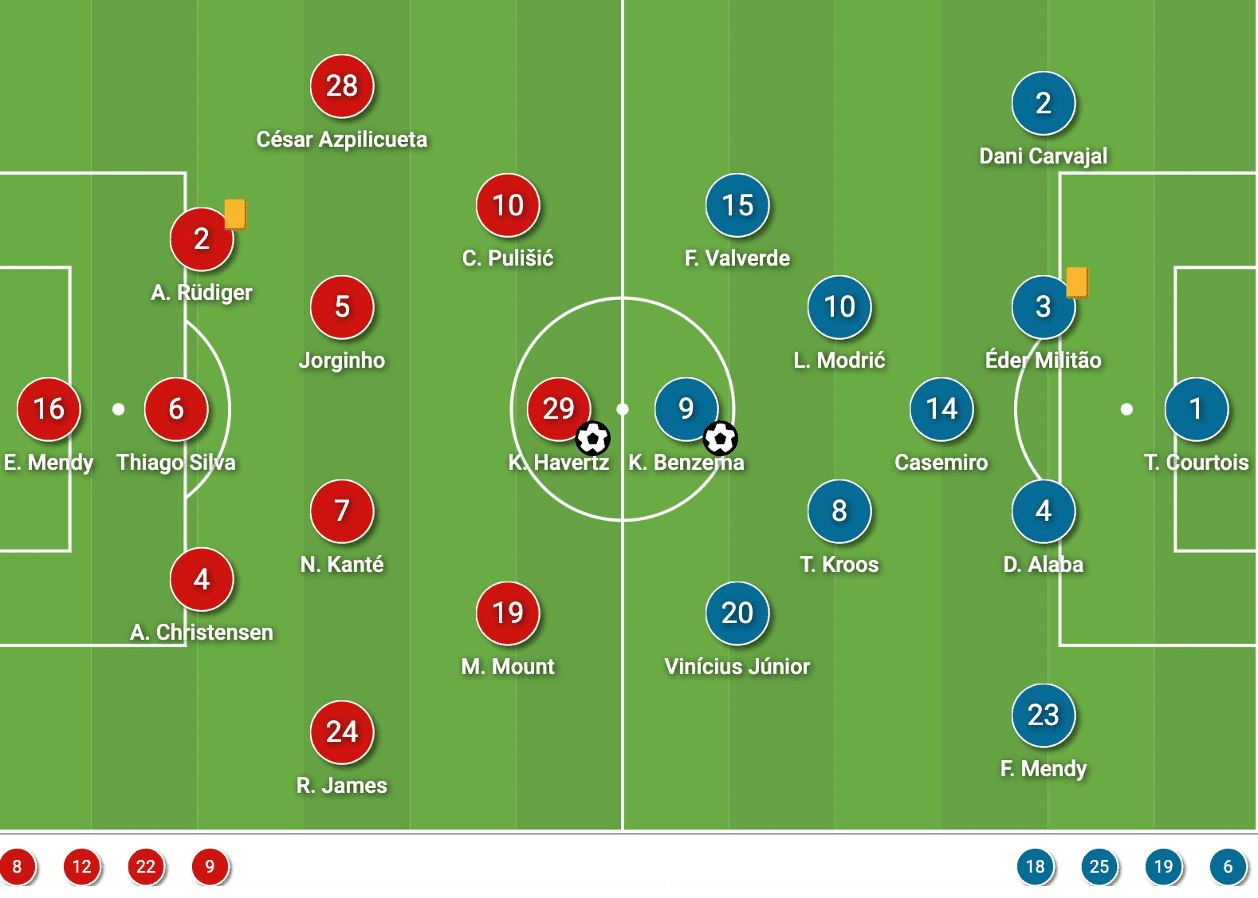
Chelsea played with a 3-4-3 formation after an unsuccessful back four experiment against Brentford. It was almost the same team that beat Madrid last season, but, Tuchel did not play a left-footed player on the left side as Marcos Alonso started on the bench, while Ben Chilwell remained injured. Instead, it was César Azpilicueta who played in that left wing-back position.
Madrid also dropped Marco Asensio from the starting lineup. With Luka Modrić, Casemiro, and Toni Kroos forming the midfield trio, Ancelotti injected energy to his side with Federico Valverde as the right-winger. This was nothing new as Zidane tried it before, but tactically, starting these players was the key to victory.
How Chelsea wanted to press
On paper, Chelsea was a 3-4-3 formation, but without the ball, the block is actually in a 5-2-1-2 shape, as we have shown in the tactics board below.
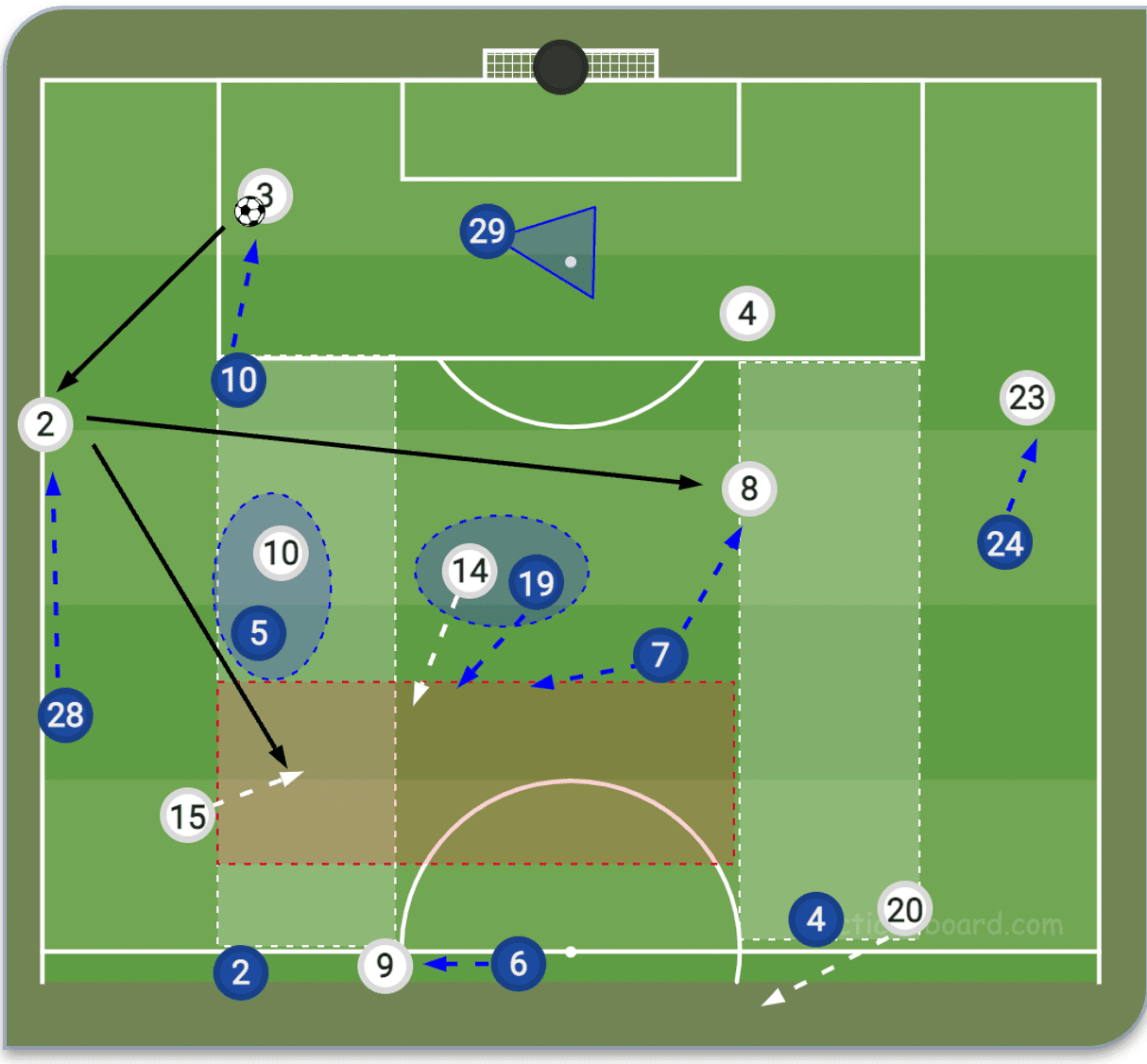
Chelsea pressed fairly high but avoided committing the centre-backs too high in the press. The wing-backs were tasked to defend asymmetrically, as Azpilicueta might be slightly closer to the centre-back, Reece James could go higher to keep Ferland Mendy under his control. That’s why the distances for both wing-backs to travel in the press was different.
Kai Havertz, as the striker, was mainly blocking the passing lane between the centre-backs with his body orientation, but that was not the most effective strategy. Since he just intentionally left the centre-backs on the ball free, sometimes we saw David Alaba was charging forward to progress the attack. If Havertz cut the passing lane between the centre-backs, Christian Pulisic should press Éder Militão because Madrid were weaker on the right side comparatively, given Vinícius Júnior was on the other flank, they did not want the opponent attacking from there.
The problem of Chelsea was the midfield defending. Mason Mount was mainly man-marking Casemiro so the Madrid 6 did not get on the ball. While the two midfielders of Chelsea were defending in a zonal-man manner. When the Madrid 8 dropped on the ball side, the corresponding Chelsea midfielder jumped – so, Jorginho on Modrić, and N’Golo Kanté on Kroos. But Chelsea were unable to solve situations when both Madrid 8s were down, and they also struggled to close spaces behind the midfield, or let the opponents manipulate them very easily.
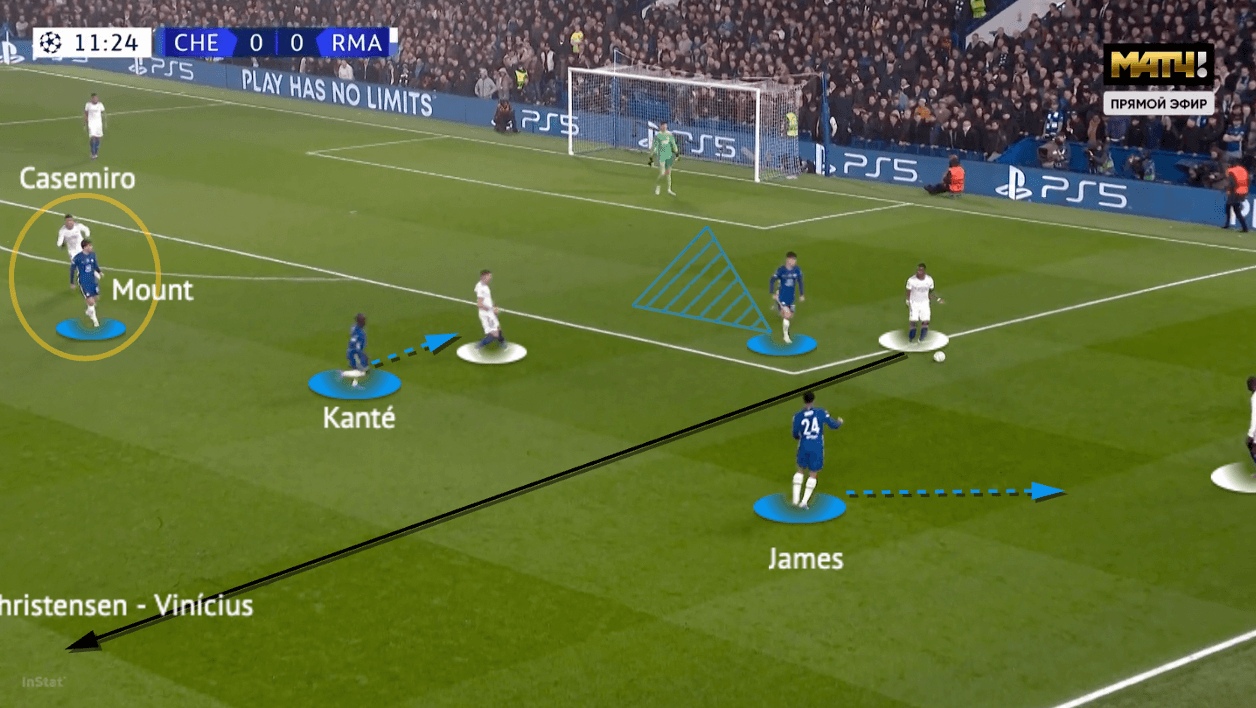
We are providing more game examples to illustrate the defending of Chelsea. IN the high pressing, this is what they did usually when everyone was doing their job. Havertz could close the centre-backs laterally to block the exchange passing lane between centre-back, but it was not necessary for him to close Alaba.
While Mount was man-marking Casemiro, Kanté stepped up to close Kroos; James was ready to go get F. Mendy, everything was correct. In this situation, Madrid was lacking a free option and Vinícius would drop to support in the half-spaces, but that was very predictable as Anders Christensen could stay very tight to close him down, so there was not much threat at all.
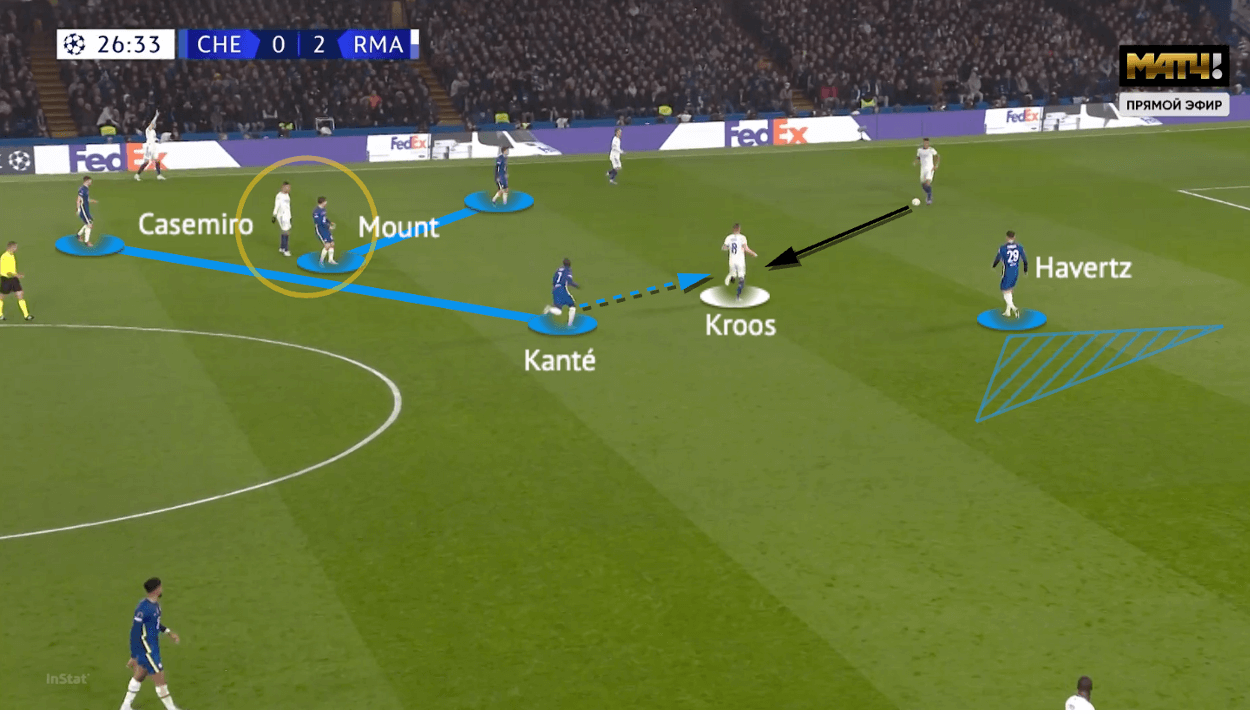
Another situation here, which was on the right side. This time, Havertz did not go to press Militão, which made sense because Alaba was relatively more dangerous with the ball. So, it was fine if Madrid were constructing the attack on that side, theoretically. It was very similar to the previous example, as Kanté was going to press Kroos when Mount was on Casemiro. Everyone in Madrid’s build-up was marked and Ancelotti’s side could not play a clear pass out in such cases.
Flexible Madrid created chances
But Ancelotti was a very experienced and tactical head coach, when Madrid players were given the freedom to roam on the pitch, the situations changed hugely and it was more difficult for Tuchel’s side to execute the tactics as explained in the above analysis.
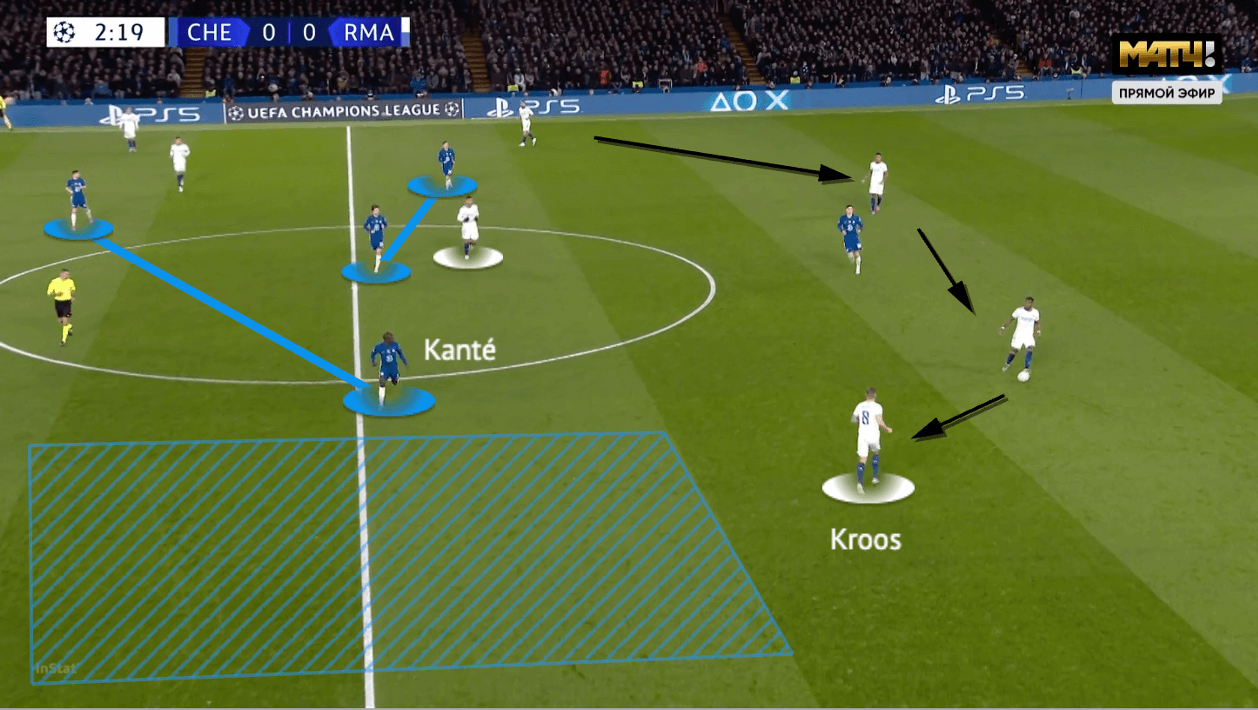
For example, in the second phase when Chelsea were dropping into a block, Kroos could drop very deep, almost like a third centre-back in the first line. Since the 10, Mount, was man-marking Casemiro, it was clear that the only player who could press Kroos was Kanté.
However, that often became a decisional dilemma for Kanté, should he get tight on Kroos at the expense of leaving big spaces in the midfield? And even if he did not, as shown in the above screenshot, Kroos would still have big space to turn and very free to play forward passes in the half-space. The 5-2-2-1 or 5-2-1-2 of Chelsea were not offering enough horizontal coverage.
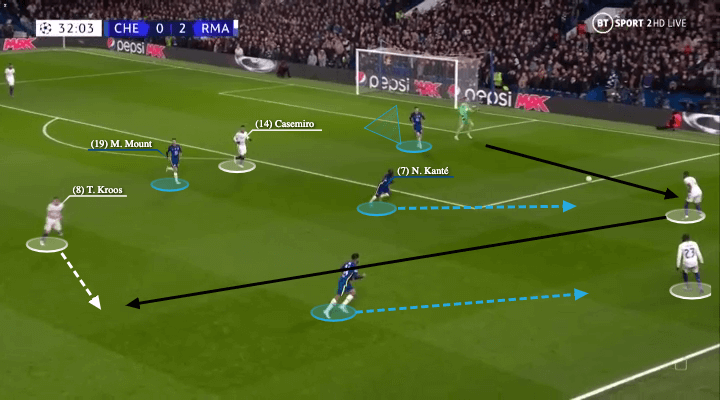
As Tuchel himself said, this was one of the worst first halves since he was at Chelsea. The players have got the pressing horribly wrong at times and let Madrid play through the press. Many conceded opportunities in the first half were a result of this situation.
The above example was one of them. In Chelsea’s high press, Havertz was merely blocking the passing lane and not pressuring the centre-backs. Instead, Kanté moved up to press Alaba because Mount was man-marking Casemiro; James was on F. Mendy.
BUT, what about Kroos? When Kanté pressed the centre-back, who could close the German international down? On the above screenshot, Kroos smartly moved behind the press and offered himself as a passing option for Alaba.
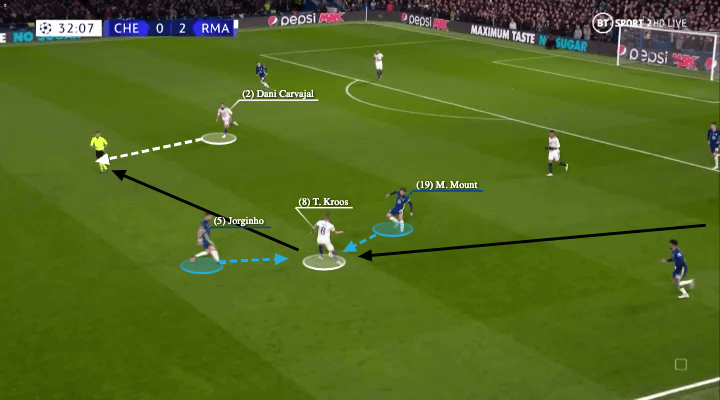
Then, because Kanté was drawn high, Kroos could calmly receive and turn in the midfield, which was never ideal as Madrid now could get out from the press. Jorginho and Mount tried to amend Kanté’s reckless press but both of them were too late to catch Kroos, who very easily released Dani Carvajal in the midfield – Madrid can go all the way to attack Chelsea’s backline.
Benzema’s first goal
We generally did not analyze the goals because the processes in those situations might be a coincidental part of the game. However, in this game, we are going to explain how the first two goals happened because both were attributed to the Chelsea pressing issue.

In the first goal, it came from the Madrid build-up where Kroos was deep to support. It was not wrong for James to stay high even though he was not on F. Mendy, while Havertz did his job to block the angle to Militão. Mount was also man-marking Casemiro.
But, Kroos was very free in the build-up as a result of Kanté giving up to follow the man, so Madrid simply cancelled Havertz with a counter-dynamic sequence which moved the ball to Militão.
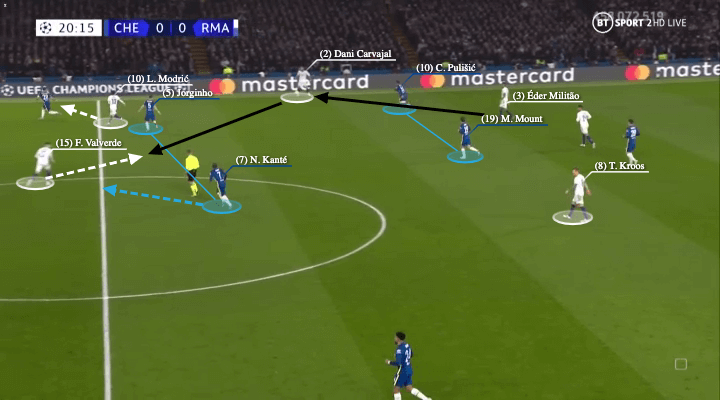
It was not a big issue if only Havertz himself was bypassed, there were still nine Chelsea outfield players behind the ball. However, the Blues got it very wrongly and outplayed by Madrid again.
When Militão was carrying the ball forward, Pulisic was caught with a meaningless pressing effort, his position was too high and not covering the angle to Carvajal, Madrid broke another line again.
Then, it was the intelligence of Madrid midfielders, as Modrić’s diagonal movement to the outside dragged away Jorginho. That opened the gap between Chelsea 6s for a diagonal pass, allowing Valverde to receive in the “red zone” which we showed in the first image. This time, Kanté abandoned Kroos to cover his partner which was not wrong, but we have to bear in mind that Kroos was free now.
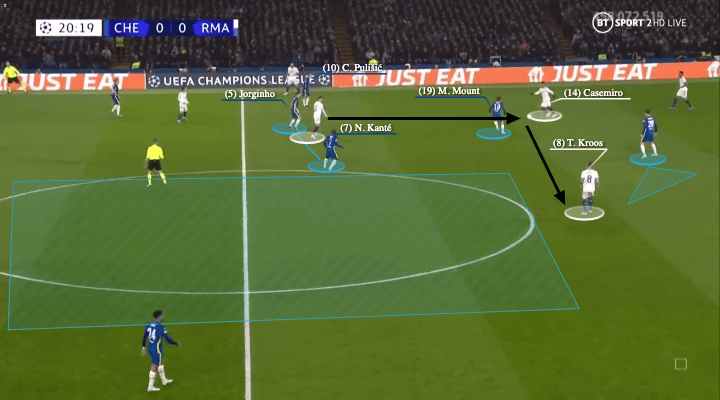
But the Madrid 8 were stretching Kanté and Jorginho really well with their positioning, so, even when Kanté got back, he was late to stop Valverde as Madrid continued with some passes in the midfield. Now, the ball was moved back to Casemiro and I thought Mount could have done a better job at closing the Brazilian midfielder, but he did not, then, it was easy for Madrid to reach Kroos, who was free after Kanté dropped back.
Again, the issue was lacking horizontal coverage with a two-man midfield only, Chelsea completely vacated the blue zone.
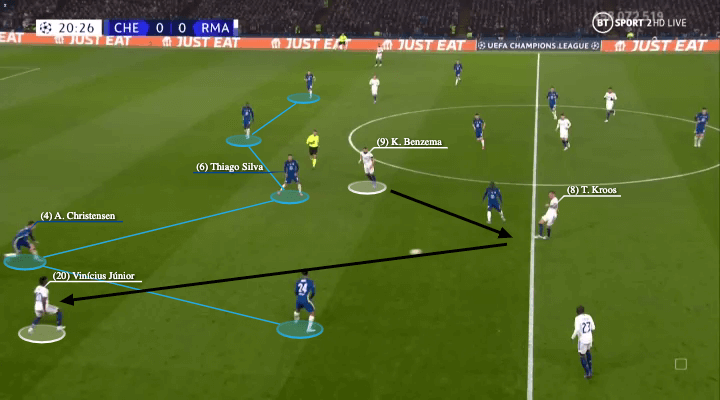
The blue zone was further exploited by Madrid for progression as shown above, as Kroos had some rooms to charge forward, connected with Benzema. The meaning of Benzema’s drop was to pull away from the centre-back, as Thiago Silva would follow, the back three of Chelsea was split. Now, Christensen must face Vinícius alone and the Danish defender struggled to keep the opponent on track. This was usually how Madrid exploited Chelsea in the TDA but now it worked in the offensive construction as well.
Then, we all knew what happened next, Madrid were unstoppable and Benzema found the net.
Benzema’s second goal
The second goal of Madrid was also attributed to a sequence that outplayed Chelsea’s pressing, as we would show in this section.
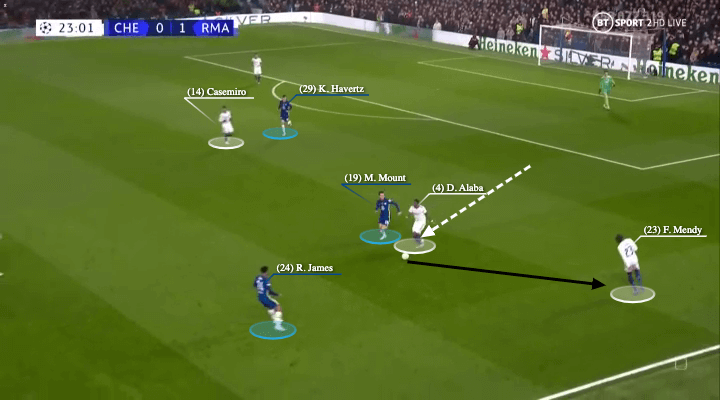
Initially, the attack began from Alaba who carried the ball forward. The Mount-Havertz duo swapped their duty temporarily, which was not an issue because theoretically, the roles were just exchanged. After chasing Alaba, Mount went on to press F. Mendy, which was not bad as they were putting continuous pressure on the opponent.
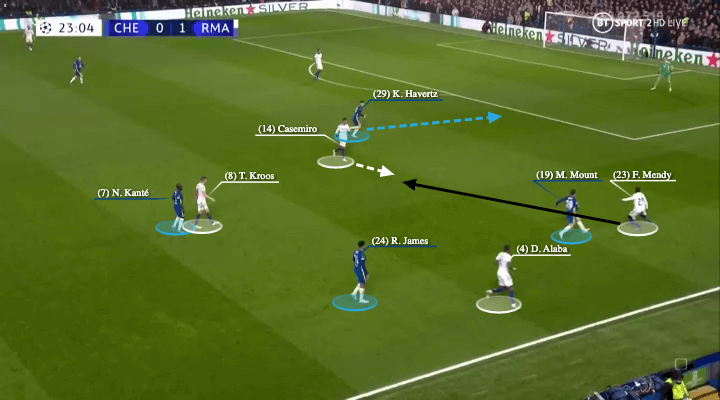
But, then, the problem rose as Havertz made a poor decision in the pressing. When Mount forced F. Mendy to pass, Havertz tried to be clever to catch the backward pass towards the keeper, instead of staying with Casemiro. As a result, the Brazilian midfielder became the free player for Madrid to transport the attack forward.
This time, the rest of the Chelsea players were doing their job, Kanté and James were on their man, but just one casual mistake, they let Madrid break the press and there was no way to catch them.
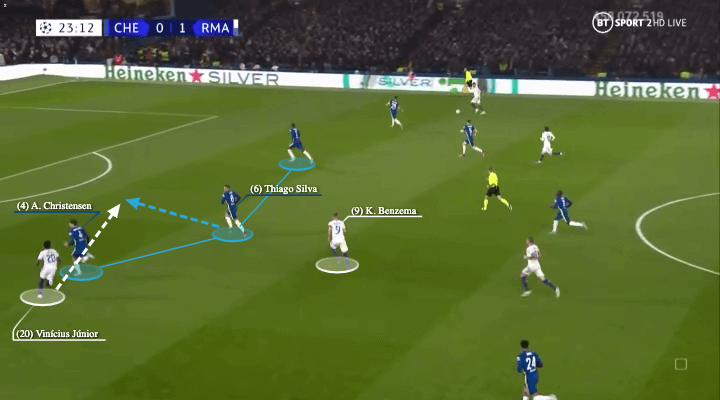
And when the attack was high up on the pitch, Chelsea were quite aware of Vinícius, even though the winger was not touching the ball, his movements could always distract the defender’s attention, including this goal. We believed Silva was more or less affected by Vinícius as well. Since Christensen had a hard time dealing with Vinícius, Silva kept an eye on his Brazilian fellow.
In the above image, when Christensen was retreating, Vinícius cleverly sneaked on the blindside, that was spotted by Silva, so the Chelsea centre-back adjusted his position and body angle a bit to defend that run.
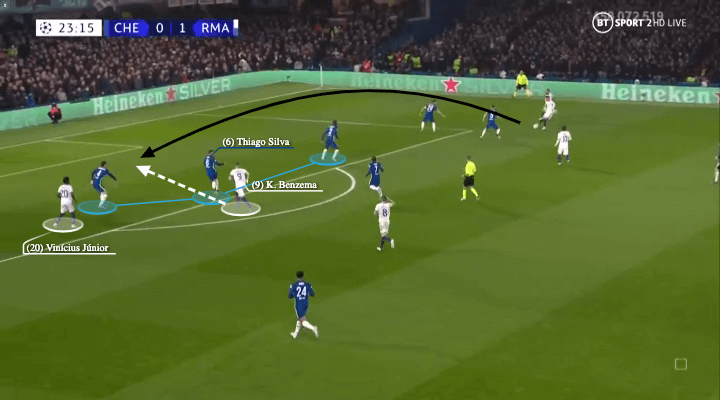
But that Vinícius run was just a decoy, he did not run through the gap actually. In the end, more or less Silva was affected by that run and suddenly he switched to defend Benzema. Then, he positioned his body angle wrongly and we saw that crazy finish.
Conclusion
It was Real Madrid in the UEFA Champions League, they were always smart and sharp in this competition, which was a really good culture implanted in the club for many years. Even if they would lose a game, usually, they would never let the opponent walk away easily. Last season under Zidane, such a mentality might be missing a bit but now Ancelotti has restored the DNA. Madrid looked stronger than they should be and mentally were always superior to the opponents, with this group of experienced players.
Regarding Chelsea, they were very disappointing in the first half. It was a UEFA Champions League game, that’s why they were punished by a top-level goal-scorer like Benzema on two occasions. It was also dismaying that the game was dead at the 48th min when that cheap goal was given away, and it would be harder for them at the Bernabéu without the second goal. But, personally, I think the tie was not dead yet, Madrid still have to give their best to make sure they were going to the semi-final, while Tuchel’s Chelsea would fight.





Comments